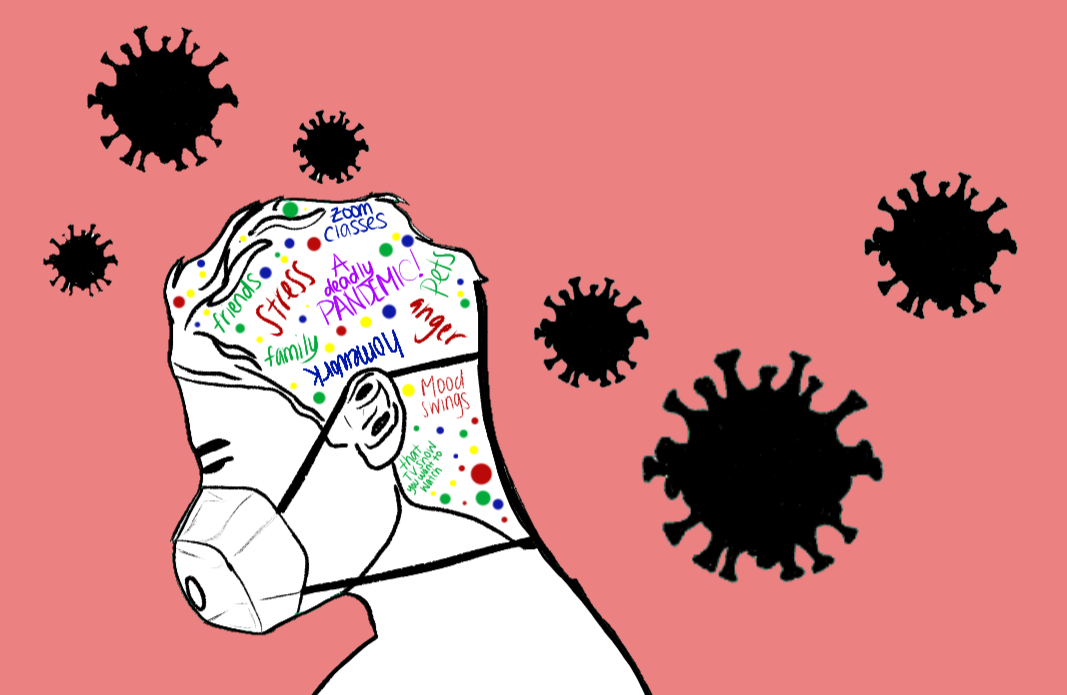Mental Health Amidst a Pandemic
April 22, 2021
Mental health has always been a major issue for high school students. These years are full of anxiety, peer-pressure, hours of homework and more stress than one person should carry. Now add a global pandemic to the pile.
What would normally be obvious signs of depression or mental health struggles in teenagers have become harder to identify during this time. Sleeping more or less than usual, not enjoying things that are normally enjoyable, and staying inside for unusually long periods are just a few of the signs that typically point to depression in teenagers.
However, staying in your room all day isn’t uncommon when you attend your classes from your room. Sleeping more or less can also be a reaction to staring at a computer screen for hours on end. Lack of enjoyment could result from just seeing the same exact things everyday.
So how could one distinguish these things? And what can you do about it when you cannot leave your house or even hang out with your friends as a relief as often as you want to? The boundaries that come from a global pandemic become even more restrictive when your mental health continues declining.
“I’d say that my mental health has taken a downfall compared to the time when we were in person,” says junior David Martinez. “Having limited interactions in person has been a downer, and staying in one place for school has also started to take its toll. During these times, I don’t really focus on myself a whole lot. Just being with others is what really kept me more ’alive’.”
While the beginning of the year was a rocky start for many students, after a while they began finding ways to help and prioritize themselves instead of just focusing on school.
“During this time, I had a really bad trip and lost track of everything,” said sophomore Alexis Martinez. “I feel like it was mostly due to my distractions appearing and having to face reality, but once I got over that phase, I started feeling better, and have even started doing things that I usually never did, like I do a skincare routine, I have more hobbies now, I read books. Over all, it had a positive outcome, but the beginning was rough.”
Teachers have taken these circumstances into account, and have aimed to recognize the stress students already face and tread carefully when it comes to workload. English and C&A teacher Amy Reilly has put a lot of thinking into how she could balance work for students.
“My approaches are different for my different groups,” Amy said. “With seniors, being open for check-ins, trying to check in with individual students who have expressed hardships, and really keeping those way out of the public eye. With my 10th graders, I try asynchronous on Fridays with all my classes. I have a bunch of silly questions I’ll ask them during attendance, and we spend longer at the beginning instead of diving straight into work. For my 9th grade advisees, it’s a lot harder because they don’t really know each other, so I’m trying to find ways to have them connect with each other.”

Teachers’ initiatives must have been helpful though, because several students believe that the understanding and extra time they now have has allowed them to prioritize themselves.
“My mental health has been improving despite what is going on in the world,” said senior Wairimu Kimani. “What’s keeping me going is the fact that I will be graduating very soon, so I have that as a motivation factor. Unlike others, I feel like virtual learning has been well for me especially since I have more time for myself.”
The diverging ideas concerning mental health during this time are what can be expected in a situation like the one we are currently in. The important factor however, is to try to take advantage of the extra time and remember to prioritize your mental health.
“It was mostly pinpointing what my issues were and how to work with them,” Alexis said. “It was difficult to work with them, like I know I need to give myself breaks before I go into complete burn out and I don’t want to do anything. Luckily, my mom pushed me to get my work done and I moved into the dorms to get academic support.”
Eastside also provides students with some support options available despite not being on campus.
“We have a counselor, Erica Pelavin, who is continuing to meet with students over Zoom and we have offered Talkspace online therapy as an alternative to counseling over video,” said Vice Principal Helen Kim in an email. “Talkspace provides counseling through an app and messaging with a therapist. You can go online (talkspace.com) to get more information on how it works. We also encourage students and families to reach out to their doctors to get referrals for services.”
Just remember, not every feeling needs a ‘diagnosis’ or a label. It isn’t even necessary to distinguish exactly what you are feeling. Just do what’s good for you, whether that be hours on Facetime with your friends, taking your classes outside for fresh air, or watching a movie that keeps you smiling for an hour.
